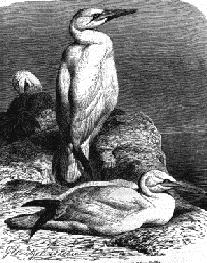The Salt Glands of Marine Birds

"Water, water everywhere, And all the boards did shrink. Water, water, everywhere, Nor any drop to drink." These lines from Samueal Coleridge's Rime of the Ancient Mariner are a fairly accurate description of the biggest problem facing any organism living in a marine habitat: that of dealing with the large amount of salty, undrinkable water in its environment. One of nature's wonders is the evolution of a stable, internal environment which allows many organisms to live in locales that are not favorable osmotically or thermally. The more extreme the environment, the more the physiology of the organism must adjust to maintain its internal stasis. This has resulted in the development of specialized organs and systems in numerous animsl. One example of this is the evolution of saly glands in birds and reptiles.
Birds, for the most part, are osmoregulatos. They strictly control the amount of water needed by their body cells, and carefully regulate the solute concentration of the internal and external cellular environment. A high concentration of solutes, such as the salts and minerals of the ocean, is a danger to that delicate balance. Salt glands, which are located just above the bird's eye, restore this balance by secreting hypertonic solutions of NaCl via a duct that empties into he nostrils. A system of active transport and counter current exchange, regulated by a series od neurotransmitters, like acetylcholine, and hormones such as corticosterone, the slat glands work in conjunction with the primitive avian kidney to rid the bird's body of toxic salt levels.
It is not surprising that Coleridge's salty poem revolved around an albatross, since members of the order Procellariiformes take in a high amount of salt through their diet of marine invertebrates and fish and dispose of it via salt glands. Other orders that use salt glands include: Pelecaniformes, Anseriformes, Charadriiformes and Cuculiformes.